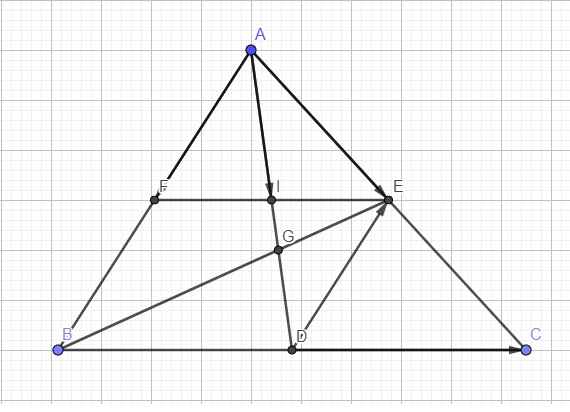Hãy nhập câu hỏi của bạn vào đây, nếu là tài khoản VIP, bạn sẽ được ưu tiên trả lời.

Do G là trọng tâm tam giác ABC nên tọa độ G:
x G = x A + x B + x C 3 = − 1 + 5 + 0 3 = 4 3 y G = y A + y B + y C 3 = 1 + ( − 3 ) + 2 3 = 0 ⇒ G 4 3 ; 0
Điểm G1 là điểm đối xứng của G qua trục Oy nên G 1 − 4 3 ; 0
Đáp án D

F là trung điểm AB \(\Rightarrow\overrightarrow{AF}=\dfrac{1}{2}\overrightarrow{AB}\) ; E là trung điểm AC \(\Rightarrow\overrightarrow{AE}=\dfrac{1}{2}\overrightarrow{AC}\)
Ta có EF song song BC (đường trung bình)
Mà D là trung điểm BC \(\Rightarrow\) I là trung điểm EF \(\Rightarrow AI\) là trung tuyến tam giác AEF
\(\Rightarrow\overrightarrow{AI}=\dfrac{1}{2}\overrightarrow{AE}+\dfrac{1}{2}\overrightarrow{AF}\)
Theo tính chất trọng tâm:
\(\overrightarrow{AG}=\dfrac{2}{3}\overrightarrow{AD}=\dfrac{2}{3}\left(\dfrac{1}{2}\overrightarrow{AB}+\dfrac{1}{2}\overrightarrow{AC}\right)=\dfrac{2}{3}\left(\overrightarrow{AE}+\overrightarrow{AF}\right)=\dfrac{2}{3}\overrightarrow{AE}+\dfrac{2}{3}\overrightarrow{AF}\)
DE là đường trung bình tam giác ABC
\(\Rightarrow\overrightarrow{DE}=\dfrac{1}{2}\overrightarrow{BA}=-\dfrac{1}{2}\overrightarrow{AB}=-\overrightarrow{AE}\) hay \(\overrightarrow{DE}=-\overrightarrow{AE}+0.\overrightarrow{AF}\)
D là trung điểm BC \(\Rightarrow\overrightarrow{DC}=\dfrac{1}{2}\overrightarrow{BC}\)
\(\Rightarrow\overrightarrow{DC}=\dfrac{1}{2}\overrightarrow{BA}+\dfrac{1}{2}\overrightarrow{AC}=-\dfrac{1}{2}\overrightarrow{AB}+\dfrac{1}{2}\overrightarrow{AC}=-\overrightarrow{AE}+\overrightarrow{AF}\)

Vì M là trung điểm BC nên
x B = 2 x M − x C = 2.2 − − 2 = 6 y B = 2 y M − y C = 2.0 − − 4 = 4 ⇒ B 6 ; 4 .
Vì G là trọng tâm tam giác ABC nên
x A = 3 x G − x B − x C = − 4 y A = 3 y G − y B − y C = 12 → A − 4 ; 12 .
Suy ra x A + x B = ( − 4 ) + 6 = 2.
Đáp án B

a) \(\overrightarrow{IA}+2\overrightarrow{IB}=\overrightarrow{BA}+3\overrightarrow{IB}=\overrightarrow{0}\Rightarrow\overrightarrow{BI}=\frac{1}{3}\overrightarrow{BA}\)
\(\overrightarrow{CI}=\overrightarrow{CB}+\overrightarrow{BI}=\overrightarrow{CB}+\frac{1}{3}\overrightarrow{BA}=\overrightarrow{CB}+\frac{1}{3}\left(\overrightarrow{CA}-\overrightarrow{CB}\right)=\frac{2}{3}\overrightarrow{CB}+\frac{1}{3}\overrightarrow{CA}\)
\(\overrightarrow{JB}=x\overrightarrow{JC}\Rightarrow\overrightarrow{CB}-\overrightarrow{CJ}=x\overrightarrow{JC}\Rightarrow\overrightarrow{CB}=\left(x-1\right)\overrightarrow{JC}\Rightarrow\overrightarrow{CJ}=\frac{1}{1-x}\overrightarrow{CB}\)
b) \(\overrightarrow{IJ}=\overrightarrow{CJ}-\overrightarrow{CI}=\frac{1}{1-x}\overrightarrow{CB}-\left(\frac{2}{3}\overrightarrow{CB}+\frac{1}{3}\overrightarrow{CA}\right)=\frac{2x+1}{3\left(1-x\right)}\overrightarrow{CB}-\frac{1}{3}\overrightarrow{CA}\)
c) Dễ có \(\overrightarrow{CG}=\frac{2}{3}\left(\overrightarrow{CB}+\overrightarrow{CA}\right)\). Để \(\overrightarrow{IJ}\)//\(\overrightarrow{CG}\) thì :
\(\frac{\frac{2}{3}}{\frac{2x+1}{3\left(1-x\right)}}=\frac{\frac{2}{3}}{-\frac{1}{3}}\Leftrightarrow\frac{1-x}{2x+1}=-1\Rightarrow2x+1=x-1\Leftrightarrow x=-2\)
Vậy \(x=-2\)tức \(\overrightarrow{JB}=-2\overrightarrow{JC}\)thì IJ // CG.
* Nhận xét: Nếu \(\overrightarrow{u}=x\overrightarrow{a}+y\overrightarrow{b};\overrightarrow{v}=m\overrightarrow{a}+n\overrightarrow{b}\)thì \(\overrightarrow{u}\)//\(\overrightarrow{v}\)\(\Leftrightarrow\frac{x}{m}=\frac{y}{n}.\)
